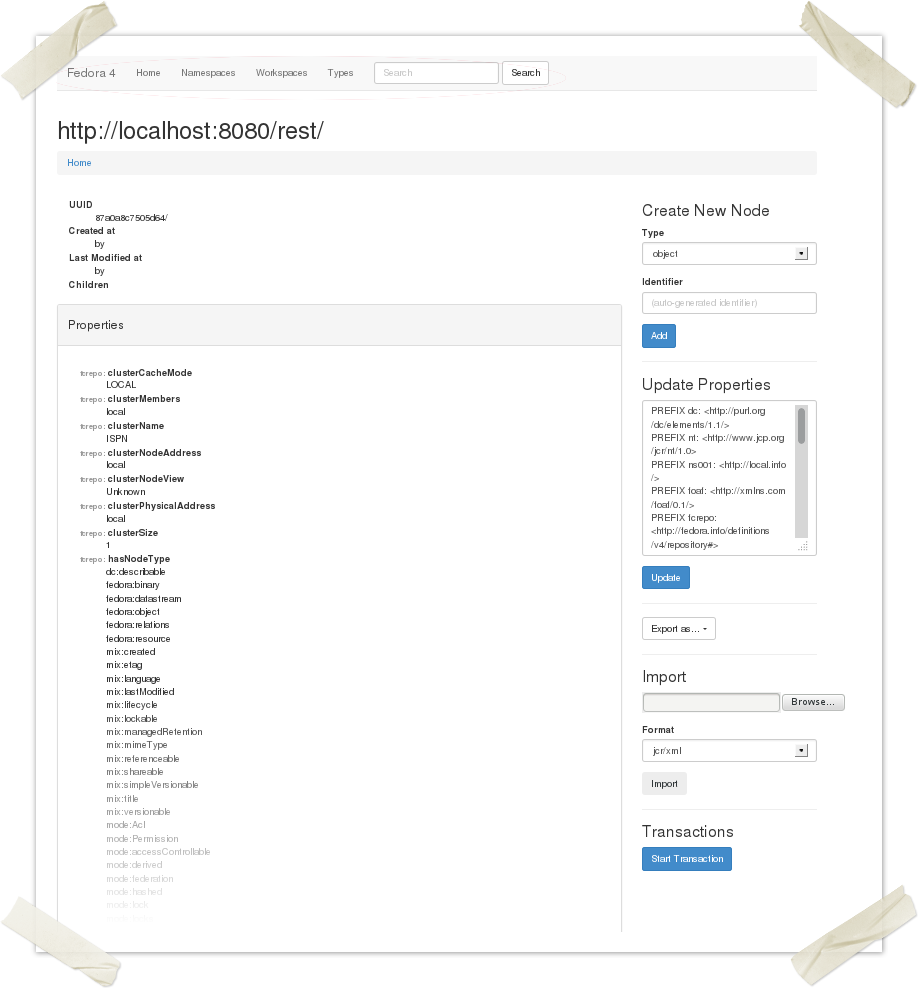Much of the functionality that is exposed through the RESTful HTTP API is also available using an HTML user interface interpreted by your favorite web browser. Whether your request for particular API HTTP endpoints results in an HTML UI or more machine-readable formats is based on content negotiation headers. This tour walks you through the major user interface components when accessing the HTTP API through a web browser.
Home Page / Node View
When you access the root path of the RESTful HTTP API you are presented with a rendering of the root level node of the default workspace within your Fedora repository
Now that you have Fedora 4 running either as a war deployed to Tomcat or via Maven and Jetty, you can navigate in your web-browser to the HTML front end of Fedora 4.
Which should be located here: http://localhost:8080/rest
The interface is comprised of several regions:
The Navigation Bar
From here you can navigate between Home/Namespace/Workspaces and the search interface.
Home
Is where the heart is, also where you will spend most of your time.
From here you can:
- Ingest new Objects and Data-streamsDatastreams.
- Inspect the properties of Objects and Data-streamsDatastreams.
- Update the properties of Objects and Data-streamsDatastreams.
- Navigate the Repository Hierarchy of Objects and Data-streams.
Fedora 4 is different from Fedora 3 in that there is an innate tree hierarchy to the repository rather than a flat hierarchy.
Navigate Hierarchy
Just below the Navigation bar, we have the path to the Object (Which is also it's identifier) displayed as the page's title.
The displayed breadcrumbs can be used to navigate back up the hierarchy to the ancestors of the currently display object.
Inspect Properties
Here all the properties that describe the object are enumerated, as well as some of the child Object / Data-stream properties.
Ingest
You can ingest new Object's and Data-streams via the "Create New Node" widget. You can either give your own identifier or use an auto-generated one.
Newly ingested Objects and Data-streams will occur under the Object in which you are currently viewing.
Currently creating Data-streams is not functional though this interface.
Update Properties
This takes a Sparql 1.1 query that Delete/Insert/Update existing properties on on the object in which you are currently viewing.
...
The user interface is divided into regions.
- Navigation bar (at the top)
- Resource information and navigation (left center)
- Optional resource actions
Navigation Bar
The navigation bar, which appears at the top of each page includes links to the following:
Resource Information
Information about the resource requested (in the case of the home page, this is the root of the default workspace) is displayed below the navigation bar, filling the left two thirds of interface.
- Object Title
If a title (either http://www.w3.org/2000/
...
- 01/
...
- rdf-schema#label or http://
...
- purl.
...
- org/
...
- dc/elements/1.1/title) is available, it is displayed here, otherwise the resource URI is.
- Object Path
Fedora 4 is different from Fedora 3 in that there is an innate tree hierarchy to the repository rather than a flat hierarchy. The path (list of ancestors) for the viewed node is presented below the object title. - Featured Properties
Very basic metadata such as the UUID and modification/creation times and users are presented below the object path - Children
Any children that the node has will be listed and linked here. - All Node Properties
All properties of the node are presented here. Hover your mouse over the namespace prefix to see the full namespace. - Inlined Resources
A subset of properties from the parent node, children nodes are presented below the properties for the subject node. Click on the grayed box to expand the list of properties or the label text to view that resource directly.
Namespaces
In Fedora 4 all namespaces used should be registered, the Namespaces page lists all registered namespaces and allows the user to register new namespaces.
Search
This page can be reached by performing a search in the Navigation bar, properties about the search are listed first such as #searchTerms Below that in a separate box the results are displayed.








